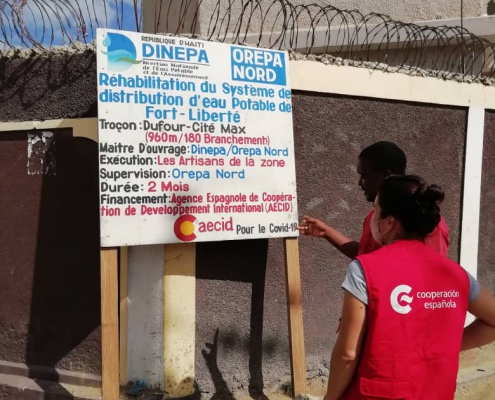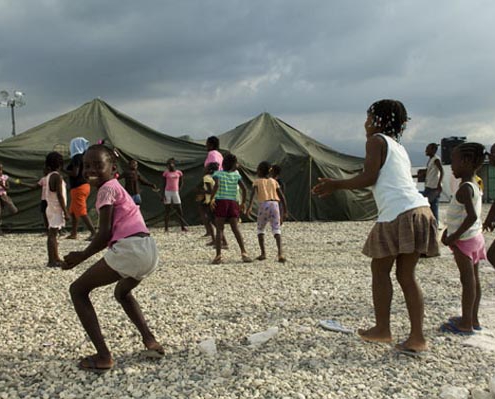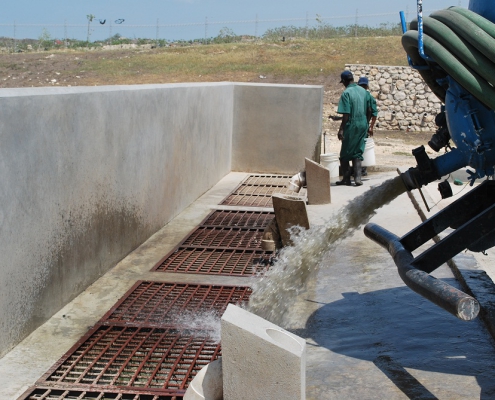Haiti
 Haiti is one of the most disadvantaged countries in the world: in 2020, it ranked 170th out of 189 countries with comparable human development index data. In addition to the conditions of poverty and extreme poverty of a large part of the population, there is a great lack of access to water and sanitation. Only 62% of Haiti’s population has access to improved water sources, far less than the 94% in Latin America and the Caribbean. The rural population’s access to clean water (47%) is much lower than in urban areas, where access reaches 75%.
Haiti is one of the most disadvantaged countries in the world: in 2020, it ranked 170th out of 189 countries with comparable human development index data. In addition to the conditions of poverty and extreme poverty of a large part of the population, there is a great lack of access to water and sanitation. Only 62% of Haiti’s population has access to improved water sources, far less than the 94% in Latin America and the Caribbean. The rural population’s access to clean water (47%) is much lower than in urban areas, where access reaches 75%.
The FCAS in Haiti has a national dimension. All the programmes have as their partner the National Directorate of Water and Sanitation (DINEPA), an institution attached to the Ministry of Public Works, Transport and Communications. Some action guidelines for the interventions are: (1) the promotion of access to drinking water through the improvement of infrastructure and service conditions, (2) the promotion of sanitation and (3) support for the creation and strengthening of the institutions that must manage the resource, with emphasis on decentralisation, providing technical training and monitoring and control instruments.
In 2020, both the bilateral programme (HTI-003-B), belonging to the bilateral portfolio, and a delegated cooperation programme, Urbayiti, are active following the satisfactory conclusion of the four interventions implemented in the multilateral framework together with the Inter-American Development Bank (IDB) and the Government of Haiti. The FCAS actions represent the largest investment of the Spanish Cooperation in Haiti, and the largest FCAS donation in the entire region, with a budget that exceeds 119 million euros in total donations. The FCAS in Haiti has promoted the coordination of actors and the search for synergies with the IDB, another of the main actors in the sector, forging a powerful alliance.
The FCAS has 3.4 million potential beneficiaries in 32 locations across the country, including many of the country’s major cities. Emergency interventions activated after the 2010 earthquake also benefited around six million people.
Programmes in Haiti have supported sector reform and the creation of DINEPA and decentralised structures. In the early years, programmes responded to the earthquake emergency and funds were directed to respond to the 2011 cholera epidemic. In Port-au-Prince, the availability of the water resource for the city was improved and support was given to the new operator involved in the provision of services.
The intermediate cities programme, in addition to increasing water coverage, has defined a successful model of service provision where operators for the first time are able to cover operation and maintenance costs via tariffs. The rural programme involved, in addition to essential infrastructure, the strengthening of rural units and water committees. An important aspect to highlight for the portfolio as a whole is that it was fully implemented despite the difficulties of the context and the amount of funds, and that these interventions have been followed by other donations from the Inter-American Development Bank (IDB) for new operations (two more phases in Port-au-Prince and an operation in Cap-Haïtien), which, although they are not Spanish funds, complement both actions carried out by the Fund.

The activities of this active bilateral programme during 2020 have been affected by the pandemic caused by COVID-19 which, together with the situation of social and political instability in the country, has further emphasised the challenge involved in continuing with the normal development of the programme’s activities. However, despite the adverse circumstances experienced during the past year, progress has been made in several cities where work is being carried out, namely Mire baláis, Aquino, Júreme, Cabaret, Archie, Hinche, Cabo Haitiano, Petito Goave, Limonada and Ti tañen.
More information

With regard to the water collection, storage and distribution works, the commissioning of a water tank at Archie has been completed, and at Hinche the materials have been received and work and exploratory boreholes will begin shortly. In Cap-Haïtien, work on the first batch will be completed in the first quarter of 2021, and the second batch will begin around the same time. In Aquino, more than 50% of the works have already been completed, and in Mire baláis the improvement of the adduction and extension of the distribution network has already been completed.
In terms of excreta treatment, the programme focuses on the development of the country’s sanitation and hygiene strategy. Activities are focused on the construction of two excreta treatment plants for sludge management in two locations: Ti Tañen, for the Port-au-Prince metropolitan region, and Limonada, in Cap-Haïtien. Progress is currently being made on both works: in Ti Tañen, the contract has already been awarded, and in Limonada, the bids received are being evaluated. In addition, during 2020, the process of defining the strategy for the promotion of good hygiene and sanitation practices was carried out, which will begin in 2021 and will focus on putting an end to open defecation in rural environments. Furthermore, the national strategy for raising public awareness of good practices for the prevention of COVID-19 was reinforced.
In terms of cross-cutting activities, on the one hand, work is being carried out to support the commercial strategy of water operators with the aim of improving their performance and thus guaranteeing the extension of the service in a sustainable manner. On the other hand, an assessment of access to water and sanitation services from a gender perspective will be carried out to identify possible inequalities and define a strategy for gender mainstreaming in water and sanitation programmes in Haiti.
Despite the impact of the pandemic, 2020 also saw progress in the EU’s Urbanita delegated cooperation programme, with the definition of the social engineering strategy to be carried out by the Haitian Directorate for Disadvantaged Neighbourhoods in Martissant, one of the most troubled neighbourhoods. In addition, during the last quarter of the year, the first visit was made to determine the schools in which public toilets will be built.

